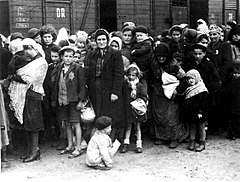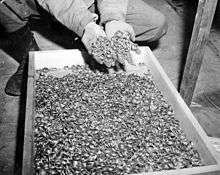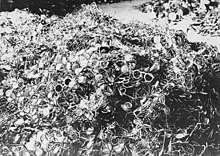Max Heiliger
Max Heiliger was a fictional name created during the Nazi era under authority of Reichsbank president Walther Funk in a secret arrangement with leader of the Schutzstaffel, Heinrich Himmler. It was a false identity used to establish bank accounts to launder valuables stolen from those killed in the Nazi system of concentration camps and extermination camps. Much other property such as art works and furniture was removed from vacated apartments and houses was collected separately and auctioned with the money going into the same accounts.[1]
| Part of a series on | ||||||||||
| The Holocaust | ||||||||||
|---|---|---|---|---|---|---|---|---|---|---|
 Jews on selection ramp at Auschwitz, May 1944 | ||||||||||
|
||||||||||
|
Camps
|
||||||||||
|
Atrocities |
||||||||||
|
|
||||||||||
|
Reparations Agreement between Israel and West Germany |
||||||||||
|
Resources Functionalism versus intentionalism |
||||||||||


Stolen Property
Stolen banknotes and jewelry along with Holocaust victims' dental gold, wedding rings, jewellery and even scrap gold melted down from spectacles-frames flooded into the Max Heiliger accounts, completely filling several bank vaults by 1942. The valuables were stolen from the Jews and other groups such as the gypsies before and after transportation by the Holocaust trains to the Nazi camps. There it was carefully counted or weighed and evaluated by SS accountants such as Oskar Groening at Auschwitz before transfer to the Reichsbank accounts in Berlin. Furniture and artworks such as paintings left in the vacated apartments and houses were collected in a separate operation and auctioned to the German population and the funds generated also transferred to the Reichsbank accounts. With valuable artwork of so-called degenerate art, they were often sent to Geneva for auction, although some was retained by Hitler's art dealers such as Hildebrand Gurlitt and a stash of such works was recently rediscovered at his son's house in Munich. Financial property such as stocks bonds and shares were transferred to the state in the same way, and companies bought for less than their true worth through aryanization. However, as the story of the Gurlitt Collection shows, the potential for corruption of such assets was substantial and an unknown amount of stolen wealth ended up in private pockets.[1] Heiliger accounts were also sometimes used to fence valuables at Berlin's municipal pawn shops.[2]
Other code names
Other code phrases associated with bank-processing of camp victims' property included Melmer, Besitz der umgesiedelten Juden ("property of resettled Jews"), and Reinhardtfonds.[2][3] The latter was a veiled reference to Aktion Reinhardt. The word umgesiedelten cloaked the true nature of the goods, since victims were usually "resettled" to a Nazi concentration camp or Nazi death camp and an early grave.
Nazi cynicism
Using the name "Heiliger" was a cynical Nazi joke, since the word means saint, from the word heilig (holy).[2] Such "humor" was not unusual in Nazi circles. For example, the one-way paths to the gas chambers at Sobibor extermination camp and Treblinka death camp were called Himmelstrasse, meaning "Heaven Street" –the road to Heaven.
See also
- Nazi loot
- Oscar Groening
- Reichsbank
- Walther Funk
References
- William L. Shirer (1990) [1960]. Rise and Fall of the Third Reich: A History of Nazi Germany (pg.973). Retrieved Nov 22, 2011.
- Gábor Kádár and Zoltán Vági (2004). Self-Financing Genocide (pg.118). Retrieved Nov 22, 2011.
- Yisrael Gutman and Michael Berenbaum (1998). Anatomy of the Auschwitz Death Camp (pg.255). Retrieved Nov 22, 2011.
_(14342874343).jpg)